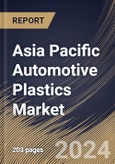The convergence of plastics and electronics is leading to the integration of smart technologies within automotive components. Sensor-embedded plastics, touch-sensitive surfaces, and smart materials are becoming more common. These innovations enhance functionalities like structural health monitoring, in-vehicle connectivity, and touch-sensitive controls, contributing to a more intelligent and connected driving experience. 3D printing or additive manufacturing is gaining traction in the automotive industry, offering new possibilities to produce complex plastic components. This technology offers rapid prototyping, customization, and the production of intricate plastic parts with reduced waste. It facilitates design flexibility and faster production cycles, impacting how certain these plastics are manufactured.
Advancements in thermoplastic composites with improved strength, heat resistance, and recyclability. Thermoplastic composites are increasingly used in structural components, offering benefits such as reduced manufacturing cycle times, ease of processing, and recyclability. Integrating aerogels, lightweight materials with low thermal conductivity, into plastic components. Aerogel-based plastics contribute to improved insulation properties, enhancing energy efficiency and thermal management in vehicles. Integration of nanotechnology to enhance plastics' mechanical, thermal, and barrier properties. Nanocomposites provide improved strength, heat resistance, and barrier properties, enabling the development of high-performance plastic components for various automotive applications.
Automotive manufacturers in India are increasingly adopting lightweight materials to improve fuel efficiency and overall vehicle performance. India's automotive sector uses these plastics to make more fuel-efficient vehicles in response to government rules to lower carbon emissions and a rising emphasis on environmental sustainability. China's focus on electric mobility has led to the development of charging infrastructure. Due to ongoing advances in materials science, China has developed specialized plastics with attributes tailored for electronic applications. Thus, due to the above-mentioned factors, the market will grow significantly in this region.
The China market dominated the Asia Pacific Automotive Plastics Market by Country in 2022, and would continue to be a dominant market till 2030; thereby, achieving a market value of $5,017.8 million by 2030. The Japan market is registering a CAGR of 4.7% during (2023 - 2030). Additionally, The India market would showcase a CAGR of 6% during (2023 - 2030).
Based on Process, the market is segmented into Injection Molding, Blow Molding, Thermoforming, and Others. Based on Application, the market is segmented into Interior Furnishings, Powertrain, Electrical Components, Exterior Furnishings, Chassis, and Under the Hood. Based on Product, the market is segmented into Polypropylene (PP), Polyurethane (PU), Acrylonitrile Butadiene Styrene (ABS), Polyvinyl Chloride (PVC), Polyethylene (PE), Polymethyl Methacrylate (PMMA), Polycarbonate (PC), Polyamide (PA), and Others. Based on countries, the market is segmented into China, Japan, India, South Korea, Singapore, Malaysia, and Rest of Asia Pacific.
List of Key Companies Profiled
- BASF SE
- SABIC (Saudi Arabian Oil Company)
- LyondellBasell Industries Holdings B.V.
- LG Chem Ltd. (LG Corporation)
- Borealis AG (OMV)
- Arkema S.A.
- DuPont de Nemours, Inc.
- The Dow Chemical Company
- Covestro AG
- Evonik Industries AG (RAG-Stiftung)
Market Report Segmentation
By Process (Volume, Kilo Tonnes, USD Billion, 2019-2030)- Injection Molding
- Blow Molding
- Thermoforming
- Others
- Interior Furnishings
- Powertrain
- Electrical Components
- Exterior Furnishings
- Chassis
- Under the Hood
- Polypropylene (PP)
- Polyurethane (PU)
- Acrylonitrile Butadiene Styrene (ABS)
- Polyvinyl Chloride (PVC)
- Polyethylene (PE)
- Polymethyl Methacrylate (PMMA)
- Polycarbonate (PC)
- Polyamide (PA)
- Others
- China
- Japan
- India
- South Korea
- Singapore
- Malaysia
- Rest of Asia Pacific
Table of Contents
Companies Mentioned
- BASF SE
- SABIC (Saudi Arabian Oil Company)
- LyondellBasell Industries Holdings B.V.
- LG Chem Ltd. (LG Corporation)
- Borealis AG (OMV)
- Arkema S.A.
- DuPont de Nemours, Inc.
- The Dow Chemical Company
- Covestro AG
- Evonik Industries AG (RAG-Stiftung)








